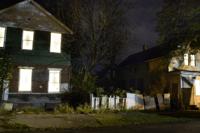“Breathing Lights,” the $1 million public art project that illuminated vacant homes in Schenectady, Albany and Troy, took its final bow on Friday during a nine-hour event at Proctors.
More than 200 people turned out for the “Breathing Lights Finale and Policy Summit,” which began in Key Hall with lunch and a question-and-answer session with the mayors of the three cities. It was followed by an afternoon of talks, videos, live performances and more Q&A in the GE Theater.
The forum concluded with a premiere screening of “Behind the Lights,” a WMHT documentary that will air at 10 p.m. Monday, April 17 on the public television station.
During the afternoon session, which focused on “Art and Inspiration,” the mood was celebratory, as project director Judie Gilmore stepped up to the podium. “Breathing Lights was never a real estate adventure” and “was misunderstood,” Gilmore said. “Breathing Lights disrupted the normalization of urban blight. It deepened and broadened existing networks.”
Speaking against a backdrop of changing images of the lighted homes on the theater’s giant screen, she listed the project’s three goals as “awareness of urban blight,” “increased appreciation of art” and “community activation and mobilization.”
Details on exactly how the Bloomberg Philanthropies grant was spent and what happened to the 200 vacant homes that pulsed with LED lights nightly in October and November will be released soon in a “massive data dump,” Gilmore said. “This is a preview of a full evaluation available in a few weeks.”
Through the breathinglights.com website and social media, images and news about the project reached people around the world, she said. Website visits totaled 40,000 from 91 countries, with the most visitors coming from the United States, Canada, United Kingdom, Germany, Italy, Russia and India.
“Sixty-one percent of website audience was young, under 34,” Gilmore said. The social media audience, via Facebook, Twitter and YouTube, was 32,500, from 37 countries. And there were more than 100 stories about Breathing Lights in the media, including The New York Times, Washington Post and Associated Press.
Officials from seven cities, including Rochester, Cleveland and Detroit, have also contacted the Capital Region to learn more about Breathing Lights. “This is putting the Capital Region on the map,” said Gilmore.
The other benefit was “social capital,” she said, as the project “cultivated a culture of collaboration.”
Recently, 143 girls from a Breathing Lights neighborhood watched the movie “Hidden Figures” in Proctors GE Theater.
“Art did that. We did that,” she said.
At one point during Gilmore’s talk, actors Aaron Moore and Erica Tryon stood on a stage in front of the screen and read positive comments about “Breathing Lights” from people in the neighborhoods.
After her talk, a panel that included Adam Frelin, lead artist for the project; and Barbara Nelson, lead architect and community engagement director, took questions from the audience.
Asked what they would have done differently, Frelin said, “we would have had people from the community involved at the very beginning.”
Frelin and Nelson agreed that the three mayors were the key that unlocked the project.
“They were courageous to expose the vacancy and blight in their cities,” Nelson said.
When it was Frelin’s turn at the podium, he honored the 11 artists who generated plays, poems, exhibits, neighborhood art-making and other community events as part of Breathing Lights. He also described the challenges of a “fluid” project that started with a plan for more than 250 illuminated homes and ended up with 200. In Schenectady, most of the lit houses were in the Hamilton Hill, Vale and Mont Pleasant sections of the city, and the Boys & Girls Club on Craig Street was one of three centers for Breathing Lights events.
“We had no curatorial decision-making. The experience of seeing the project was even a surprise for me.” Frelin showed a two-minute video depicting many of the houses, which he called “places of pain and loss,” glowing in the darkness.
His other surprise was the clothing, broken furniture, family photos and other objects inside the abandoned homes.
“Each house became a portrait of who once was there.”
Frelin fondly remembered the residents of the neighborhoods who came over to see what he was doing during the installation.
“This is the most beautiful thing I’ve ever seen,” one man told him.
Another woman had no idea that Frelin was making art. “Are you trying to get rid of the bedbugs?,” she asked.
At first, Gilmore said, people didn’t understand Breathing Lights. “But when the lights went on, attitudes changed. Their brains turned off and their hearts turned on. It was beautiful. We brought beauty to the region.”
Reach Gazette reporter Karen Bjornland at 395-3197, kbjornland@dailygazette.net or on Twitter @bjorngazette.









